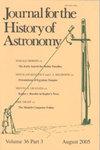Poetic Structures of the Cosmos
IF 0.3
3区 哲学
Q3 HISTORY & PHILOSOPHY OF SCIENCE
引用次数: 0
Abstract
any possibility both for “astrological images” and for nativities, since the variation of intensity does not mean a change of the quality itself; a simple variation of intensity in a quality seems insufficient to establish the qualitative difference required for an individual horoscope. Later the physicians Arnald of Villanova and Pietro d’Abano will explicitly refer to this latitude of quality, but in a very different framework in which there will be a room for an individual/accidental occult property. In any case, DR’s appealing analysis forces us to clarify the terms of the issue. In chap. 6 DR tackles Roger Bacon’s attitude toward the same kind of practices such as talismans, the power of words and fascinatio. He rightly recalls that these practices, when they are based on true astrology and natural causes, are never called “magic”—a word which Bacon attributes to wrong and evil practices. The three first parts of this book, dedicated to a conceptual approach, essentially focus on three authors and an anonymous text of the 13th century. The last part, which addresses the following centuries (1300–1500), takes “an institutional, socio-political and cultural” approach. This shift of approach for the later period might seem curious, but DR thereby demonstrates his freedom of thought and accurate pragmatism, without claiming to be exhaustive. DR here seeks to contradict Paul Lawrence Rose who, in 1975, on the one hand rightly discarded the misconception of an opposition of humanists toward mathematics but, in the other hand, asserted that the humanists were “antagonistic [. . .] towards judicial astrology” (p. 364). Chap. 9 addresses the famous Regiomontanus and also the Paduan Pietro d’Abano, one of the medieval physicians who went far in theorizing the importance of astrology for the physician. Chap. 10 addresses the “institutional foundations” or universities, Chap. 11 other circles, such as the Italian courts. Darrel Rutkin is a leading expert on medieval astrology. This fascinating book, the first stone of an ambitious edifice, provides many fundamental elements for understanding the place of astrology in the philosophical, theological, and scientific worldviews of the Middle Ages. The reader is often led to see the question from unexpected angles and is thus strongly stimulated in his thought. Accordingly, we can only hope that the following volumes of this inspiring and extraordinary program will be published soon.宇宙的诗意结构
“星象”和耶稣诞生的可能性,因为强度的变化并不意味着质量本身的变化;一种性质的简单的强度变化似乎不足以建立个体占星术所要求的质量差异。后来,医生Arnald of Villanova和Pietro d 'Abano将明确地提到这种质量纬度,但在一个非常不同的框架中,将有一个单独/偶然的神秘属性的空间。无论如何,DR的吸引人的分析迫使我们澄清问题的条款。在第六章中,DR探讨了罗杰·培根对护身符、语言的力量和魅力等同样类型的实践的态度。他正确地回忆说,这些实践,当它们基于真正的占星术和自然原因时,从来不会被称为“魔法”——培根把这个词归因于错误和邪恶的实践。这本书的前三个部分,致力于一个概念性的方法,主要集中在三位作者和一篇13世纪的匿名文本上。最后一部分讲述了接下来的几个世纪(1300-1500年),采用了“制度、社会政治和文化”的方法。这种后期方法的转变可能看起来很奇怪,但DR因此展示了他思想的自由和准确的实用主义,而不是声称他是详尽的。DR在这里试图反驳保罗·劳伦斯·罗斯,他在1975年一方面正确地摒弃了人文主义者反对数学的误解,但另一方面又断言人文主义者“反对司法占星术”(第364页)。第九章讲述了著名的Regiomontanus和Paduan Pietro d 'Abano,他是中世纪的一位医生,他在理论上阐述了占星术对医生的重要性。第10章讲的是大学的“机构基础”,第11章讲的是其他圈子,比如意大利法院。达雷尔·鲁特金是中世纪占星术方面的权威专家。这本引人入胜的书,是一座宏伟大厦的第一块石头,为理解占星术在中世纪哲学、神学和科学世界观中的地位提供了许多基本要素。读者往往会从意想不到的角度来看待问题,从而在思想上受到强烈的刺激。因此,我们只能希望这个鼓舞人心的非凡计划的以下几卷将很快出版。
本文章由计算机程序翻译,如有差异,请以英文原文为准。
求助全文
约1分钟内获得全文
求助全文
来源期刊

Journal for the History of Astronomy
地学天文-科学史与科学哲学
CiteScore
0.50
自引率
25.00%
发文量
44
审稿时长
>12 weeks
期刊介绍:
Science History Publications Ltd is an academic publishing company established in 1971 and based in Cambridge, England. We specialize in journals in history of science and in particular history of astronomy.
 求助内容:
求助内容: 应助结果提醒方式:
应助结果提醒方式:


